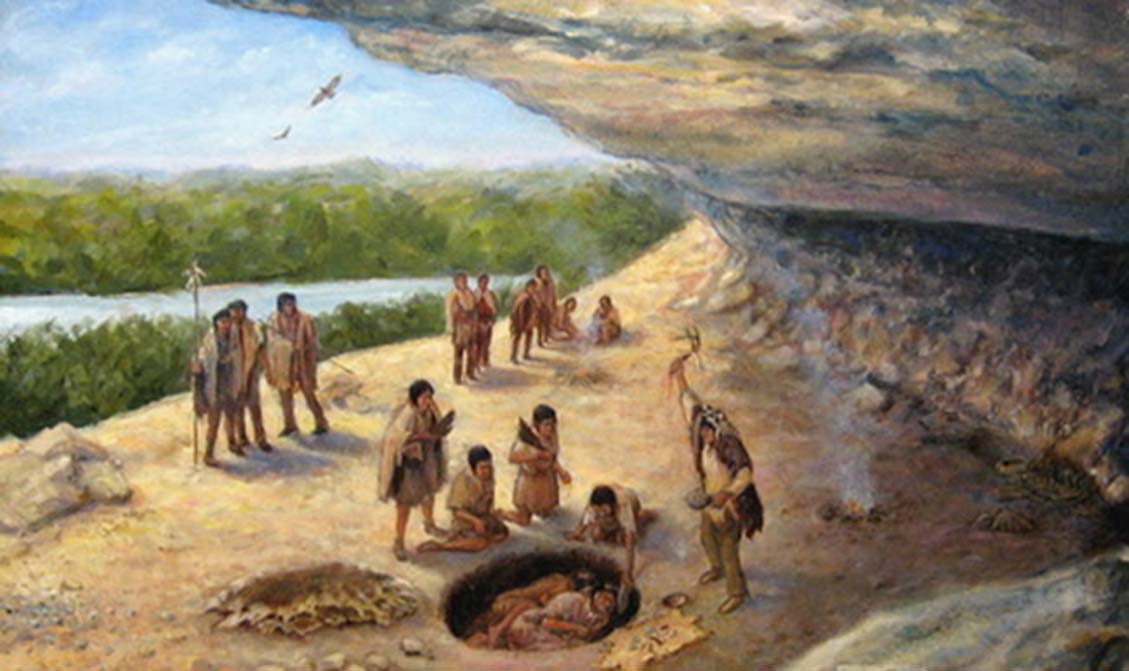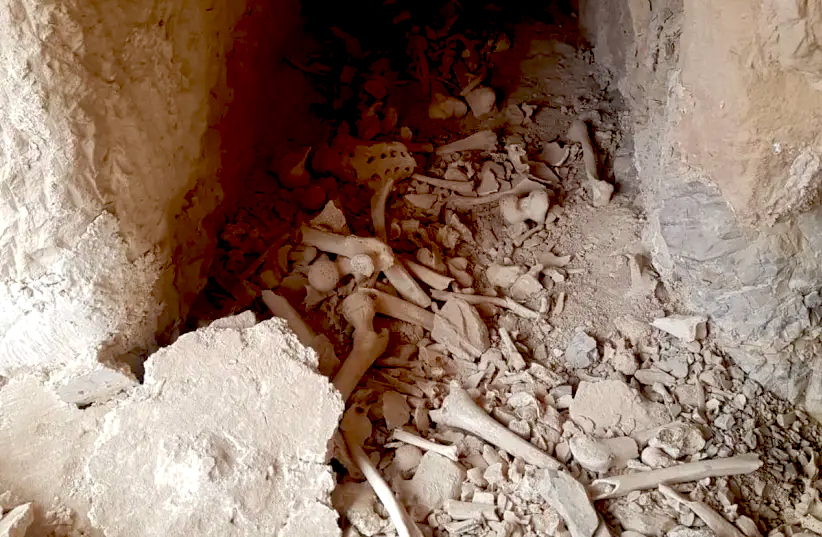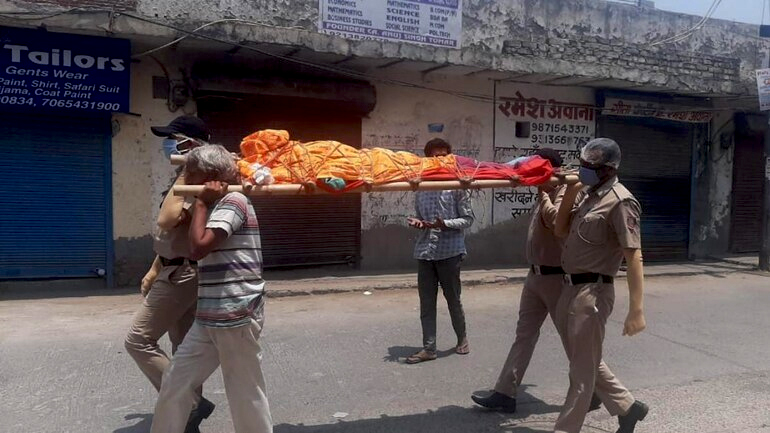
Native American Burial
Burial traditions have held great importance since ancient times, and this is true of many cultures and peoples. The mummification of Egyptians is well known to us, and their practice of removing fluids from the body prior to embalming to slow decay is still in use today. All across the Mesopotamian landscape, many feared lying “unburied” after death, since it was considered a curse. This was also the case with ancient Israel. Listed among the curses of Deuteronomy 28—incurred by our ancestors for the sin of covenant-breaking—is lying unburied:
26And your dead body shall be food for all birds of the air and for the beasts of the earth, and there shall be no one to frighten them away.
—Deuteronomy 28:26
But the mention of this curse isn’t restricted to Deuteronomy 28. The Psalmist Asaph refers to the curse in Psalm 79:2, and several prophets—chiefly Jeremiah (7:33; 14:16, etc.)—threatened it in various Scripture passages. The importance of proper burial, on the other hand, is given special prominence in several Scriptural accounts, particularly when someone of stature passed away. Joshua is a good example, as we are given location details concerning his burial:
29Some time later, Joshua son of Nun, the servant of Yah, died at the age of 110. 30And they buried him in the land of his inheritance, at Timnath-serah [also known as Timnath-heres, according to Judges 2:9] in the hill country of Ephraim, north of Mount Gaash.
—Joshua 24:29 – 30
We can see the great significance of honorable burial in Abraham’s day, given the account in Genesis 23, with the purchase of the famed Cave of Machpelah. Chapter 49 and verses 29 to 32 of that same book clearly reveal that the cave was expressly for patriarchal burial—and that of the three patriarchs’ wives: namely Sarah, Rebekah, and Leah. Genesis chapter 50 gives us another illustration of burial preparation, when, in verses 24 and 25, Joseph gives specific orders to his brothers to carry his bones from Egypt into the Land of Promise, which their descendants were prophesied to enter. The brothers obviously passed these orders down to their children, for when we arrive at the time of Moses and the Exodus from Egypt, we are told:
19 Moses took the bones of Joseph with him, for Joseph had made the sons of Israel swear to do this….
—Exodus 13:19
After all is said and done, we learn of Joseph’s final resting place in the days of Joshua:
32 As for the bones of Joseph, which the people of Israel brought up from Egypt, they buried them at Shechem, in the piece of land that Jacob bought from the sons of Hamor the father of Shechem for a hundred pieces of money. It became an inheritance of the descendants of Joseph.
—Joshua 24:32
Even Tobit, of the tribe of Naphtali, writing in his apocryphal eponymous book, shares his virtuous acts concerning burial, which he conducted at a most dangerous time at that: during the Assyrian captivity in the reign of King Shalmaneser.
16During the time of Shalmaneser, I gave away a lot of money to my relatives, my fellow Judahites. 17I gave a portion of my food to the hungry and clothes to the naked. Whenever I saw that the corpse of anyone from my nation had been flung outside the wall of Nineveh, I buried it. 18I also buried anyone whom Sennacherib murdered after fleeing home from Judea, at the time when the king of heaven had punished him for all his insulting actions. In his rage Sennacherib killed many Israelites. However, I would take their bodies and bury them secretly. Sennacherib looked for them, but he didn't find them.
—Tobit 1:16 – 18
In essence, the height of ancient Hebrew culture held the burial of foreigners and complete strangers in league with feeding the hungry and clothing the naked. While we have these and other tidbits to go on concerning the burial practices of the ancient Israelites, there is very little in the way of detailed specifics in pre-Messianic times, even in the Torah. What is written in the instruction refers to the forbidden, such as priests and other tribal members not being defiled by dead bodies, including the carcasses of animals. Leviticus 5:2; 21:1, 11; Numbers 5:2 and 19:11, among others, speak on these restrictions. Israelites were also told to not leave the bodies of criminals hanging on a tree overnight in Deuteronomy 21:22 – 23, which is another prophetic passage. We are also shown how long we are to mourn the dead, that being thirty days (see Deuteronomy 34:8 and Numbers 20:29). The Egyptians, on the other hand, mourned their dead for over two months, according to Genesis 50:3.
“The height of ancient Hebrew culture held the burial of foreigners and complete strangers in league with feeding the hungry and clothing the naked.”
In Israelite culture, being buried among close kin and on one’s ancestral land was also of great importance. The patriarch Jacob requested this in Genesis 49:29, and we have already cited Joseph’s similar desire. Another illustration is found in 2 Samuel 19, which tells of an ally of King David’s, the wealthy Gileadite Barzillai, who had “provided food for the king during his stay in Mahanaim” (verse 32). David, set on returning to Jerusalem with his household and many of his men, was met by Barzillai who had come down to escort him as he crossed the Jordan. Never one to forget a kindness, David says to Barzillai, “Come over with me, and I will provide for you with me in Jerusalem” (2 Samuel 19:33).
34But Barzillai said to the king, “How many years have I still to live, that I should go up with the king to Jerusalem? 35I am this day eighty years old.… 36Your servant will go a little way over the Jordan with the king. Why should the king repay me with such a reward? 37Please let your servant return, that I may die in my own city near the grave of my father and my mother.”
—2 Samuel 19:34 – 37

Bones believed to be 2,000 years old discovered in Jericho
While in exile, Nehemiah too, in requesting permission of King Artaxerxes to return to Judah to rebuild the city, referred to Jerusalem as “the city of my fathers’ graves” (Nehemiah 2:5). It is for this reason, this longing to be buried among family, and on shared land, that the Israelite tomb came to be, which was usually a natural cave or rock-cut chamber close to the city. Hundreds of Second Temple-era tombs within a complex of burial caves have been discovered in Jericho by archaeologists specializing in necropoleis. This explains why, in 2 Kings 13:21, a man is buried in a qeber (H6913: “grave,” “sepulcher”) by being thrown in among the bones of Elisha. In ancient times, there were no burial plots in a cemetery setting, where coffins were lowered six feet into the ground and covered with dirt. Neither did we embalm our dead in the manner of the Egyptians, despite the accounts of Jacob and Joseph being thus treated in the book of Genesis (50:2, 26). They were exceptions to the rule, and it was probably done to preserve their bodies until transport to their final resting places could be accomplished. Bear in mind also that Joseph (and his father Jacob by extension) was on the level of a dignitary.
In keeping with that thought, it must be understood that not all Israelites were afforded burial in tombs, be they rock-cut or natural. Sepulchers of this sort were restricted to the elite, or families who could afford them (note the burial of Yeshua in the account of Joseph of Arimathea found in Mark 15:43 – 46). Those who held low societal status, such as the poor, were buried in a different manner. A picture of this other type of burial is painted for us in 2 Kings 23:6, where we see King Josiah disposing of Israel’s wooden image, the Asherah, at the brook Kidron.
6… there he burned it, ground it to powder, and threw its dust on the graves of the common people.
—2 Kings 23:6
These graves were in a valley setting. We get a similar account in the book of Jeremiah, where we hear of “the burial place of the common people” (Jeremiah 26:23). This is akin to what we read about in the First Century Messianic period, which speaks of a potter’s field:
7So they took counsel and bought with them the potter’s field as a burial place for strangers.
—Matthew 27:7
Now, communal burial fields aside, the people of ancient Israel favored being buried with relatives whenever possible; so much so that upon nearing death, the usual refrain would go up of one desiring to be gathered to one’s people. This was also termed “sleeping with” one’s fathers, since death was expressed as sleep, or rest, in ancient times via the word shakab (H7901: “lie down,” “to sleep”). This is evident from verses like 1 Kings 2:10 and 1 Kings 11:43. When we arrive at the First Century Messianic period, the concept had been largely abandoned as a result of many exiles and the partial loss of heritage, though Yeshua spoke in these terms on several occasions. We see him employing the Scriptural death-as-sleep concept in Matthew 9:24 and John 11:11 – 14, yet his hearers did not understand its meaning.
While the Pre-Messianic Scriptures are scant on burial preparation details, the Messianic Writings offer a little more. Preparing the body of the Messiah for burial, we are told, involved a mixture of myrrh and aloe weighing some seventy-five pounds, thus, “they took the body of Yeshua and bound it in linen cloths with the spices, as is the burial custom of the Judahites” (John 19:40). Even among the lower rungs of society, burying the dead seemed to be a communal affair, in which many people of a given town were involved.
11Soon afterward he went to a town called Nain, and his disciples and a great crowd went with him. 12As he drew near to the gate of the town, behold, a man who had died was being carried out, the only son of his mother, and she was a widow, and a considerable crowd from the town was with her.
—Luke 7:11 – 12

Funeral bier similar to Israelite version being used in modern India
Verse 14 reveals that the man was carried on a bier, which is what David walked behind in 2 Samuel 3:31, called in the Hebrew, mittah (H4296: “place of reclining,” “couch,” “bed”). 2 Chronicles 16:14 says that King Asa, who was buried “in the tomb that he had cut for himself in the city of David,” was also laid “on a bier that had been filled with various kinds of spices prepared by the perfumer’s art.” Note that the scene in the town of Nain from Luke 7 also demonstrates that a great deal of time was not allowed to pass between one’s death and burial, since embalming was not practiced. We see this kind of burial haste with Lazarus as well. John 11 reveals that Yeshua was aware that Lazarus had fallen ill in Bethany, so he lingered near that area for two days on account of this fact. But when he heard Lazarus had died, he went to see him, and “he found that Lazarus had already been in the tomb four days” (John 11:17). And again, death and burial being a communal affair, we are told in verse 19 concerning Lazarus’s passing that “… many of the Judahites had come to Martha and Mary to console them concerning their brother” (John 11:19).
When it comes to burning the dead, or what some may view as cremation, we go farther afield from what is common in Western culture. Fires were usually burned in honor of a king, having nothing to do with their bodies being burned, as we see with the end of the verse we cited above, 2 Chronicles 16:14, which says of Asa, “they made a very great fire in his honor.” And Israel did not honor just any old king by burning fires. Upon the agonizing death of the wicked king Jehoram, 2 Chronicles 21 says:
19His people made no fire in his honor, like the fires made for his fathers. 20… And he departed with no one’s regret. They buried him in the city of David, but not in the tombs of the kings.
—2 Chronicles 21:19 – 20
Burning a body with fire, on the other hand, held quite another meaning; usually it was reserved for the wicked, as seen in the judgment of the priests of idol worship at the hand of King Josiah.
20And he sacrificed all the priests of the high places who were there, on the altars, and burned human bones on them. Then he returned to Jerusalem.
—2 Kings 23:20
In like manner, Achan and his entire family suffered the same fate.
25And all Israel stoned him with stones. They burned them with fire and stoned them with stones. 26… Then Yah turned from his burning anger.
—Joshua 7:25
And Yah personally sent fire to destroy the followers of Korah:
35And fire came out from Yah and consumed the 250 men offering the incense.
—Numbers 16:35
Without question, this is a precursor of Yah’s final judgment of the wicked, as vividly pictured in the following prophecies:
1For behold, the day is coming, burning like an oven, when all the arrogant and all evildoers will be stubble. The day that is coming shall set them ablaze, says Yah of hosts, so that it will leave them neither root nor branch.
—Malachi 4:1
11O Yah, your hand is lifted up, but they do not see it. Let them see your zeal for your people, and be ashamed. Let the fire for your adversaries consume them.
—Isaiah 26:11
6Let him rain coals on the wicked; fire and sulfur and a scorching wind shall be the portion of their cup.
—Psalm 11:6
Yeshua’s parables also clearly point to the correlation of fire with Yah’s judgment:
40Just as the weeds are gathered and burned with fire, so will it be at the end of the age. 41The Son of Man will send his messengers, and they will gather out of his kingdom all causes of sin and all law-breakers, 42and throw them into the fiery furnace. In that place there will be weeping and gnashing of teeth.
—Matthew 13:40 - 42
But Revelation 20 says it all:
14… This is the second death, the lake of fire. 15And if anyone’s name was not found written in the book of life, he was thrown into the lake of fire.
—Revelation 20:14 – 15
This is presented to say that cremation, therefore, was not something we practiced as part of our customs, though the preceding burial practices are according to the customs of the ancient Israelites as outlined in Scripture and the Messianic Writings. And while we see certain elements that could be compared to modern burial customs, such as funeral processions, communal support, and designated sepulchers akin to grave plots, there is little similarity between that time and our modern day. And just as the “sleeping” or “rest” aspect of death was lost on the Israelites of the Messianic era through captivity, so too have modern Israelites lost all of their heritage and ancient customs through slavery. Another point can be drawn from the life, or death, of Joseph. While he was an official of physical Egypt, he lived according to some of their customs, particularly with the act of embalming and being placed in a coffin (Genesis 50:26). In this way, both he and Jacob were precursors of our experience by way of those acts, as Israelites of this era who are living in spiritual Egypt must undergo burial customs of the land, which involve coffin burial and modern embalming methods that employ the use of chemical solutions based on formaldehyde.
But while our ancient burial customs are lost to us through this present captivity, which shall be overturned in due time, we do what we can to please the Most High and abide by Torah, while simultaneously living according to many of the customs of the land as its forced citizens, not unlike the Babylonian captives in Daniel’s day. But that does not mean compromising our standards and violating Yah’s law to appease our heathen rulers.
Other Articles You Might be Interested In
Feedback Form
TESTIMONIALS
Thank you kindly for all the work you've invested in the word & teaching the flock. Pray the Most High's will & covering for you and your family. Know that your efforts are appreciated.
—Kenyana M.
This article was very insightful with knowledge on evidence in scripture of how to bury our people.
—MalakaYah Y.
Thank you so much for this. This was very well done. I researched this and came to the same conclusion.
—Wendy J.
Kingdom living. This is powerful and insightful, because each one of us must pass from this life.
—Jim T.
Shalom. I want to thank you for your inspired lessons. They are very informative and beneficial to our well-being. Thank you.
—Queen Ana
Excellent topic and reference for the days we are living in, especially with all that is going on now. I applaud!
—Zena O.
Shalom. I know it was Father YAH that placed on your heart to send this to me. I was on the list for cremation because I didn't want to be a burden to my children. Since then I removed myself. YAH spoke in my spirit that this was for the wicked even though I had no real proof. I knew it was YAH when I saw this post in my email. Todah for your portion in these perilous times as we await the culmination of our captivity.
—Charla
I believe cremation is not scriptural. However, unless you actually read the WORD how would any know this? Torah, Bible is meant to be read and not changed in any way. Thank you for pointing this out, for many simply do not know. Their preachers do not submit to YAHUAH's instruction. Much loving kindness.
—Susana S.
Great reading and understanding of our past culture. I enjoyed it and read it a second time but slower to take everything in. Todah ach. Shalom.
—Eddie H.
Thank you for writing the article "Death Burial & Cremation." Very eye-opening and something that's not ever talked about since as a nation, we have so readily accepted the practices that we have come to [view] as normal. Thank you.
—Althea W.
Shalom, Brother. Thank you for the message of the death, burial, and cremation. I have known people who were cremated and [wanted] to know, if possible, what would now be their part in the plan of the Messiah. This topic has been a concern of mine for a long time, because in reading the bible over time, it makes mention of burial and not burning. However, in "modern" times, it is the fashion to cremate the dead. Really want to thank you for clearing this up for me as I have a better foundation to stand on moving forward and to give a true answer when I am asked what my choice of burial is at death. Peace and love.
—Lydia S.





